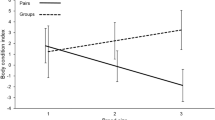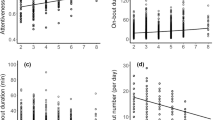Abstract
Food sharing with immatures is an important and relatively well studied aspect of infant care in many cooperative species. A key point that has not yet been fully addressed, however, is how increasing the difficulty of obtaining food influences the willingness of breeders and helpers to provision immature offspring. We used captive golden headed lion tamarins (Leontopithecus chrysomelas) to examine how breeders and helpers differ in provisioning juvenile individuals according to the level of difficulty of obtaining food. The level of difficulty in obtaining food was varied by placing the food inside tubes that allowed access only by adults. When food acquisition became more difficult, food sharing with juveniles and breeding females increased significantly. Begging calls by breeding females and juveniles increased during the experimental condition, which probably led to increases in food sharing. Breeders and helpers did not differ in their contribution to provisioning when food was easily available, nor did they differ in their contribution when food was difficult to obtain. Breeding males in callitrichids have a prominent role in transferring food to offspring, but contrary to our expectations, they did not increase food transfer in the experimental condition. An unexpected result was the increased investment of the breeding female into her current offspring when the level of difficulty of obtaining food was higher. We suggest that breeding lion tamarin females are not as constrained by reproductive costs as breeding females of other callitrichids. Degree of reproductive skew is hypothesized as a factor affecting the contribution of breeders and helpers to offspring care in cooperative breeding mammals, though we suggest that more studies are needed to validate such a generalization.





Similar content being viewed by others
References
Association for the Study of Animal Behaviour (ASAB). (1991). Guideline for the use of animals in research. Animal Behaviour, 41, 183–186.
Baker, A. J., Bales, K., & Dietz, J. M. (2002). Mating system and group dynamics in lion tamarins. In D. G. Kleiman & A. B. Rylands (Eds.), Lion tamarins biology and conservation (pp. 188–212). Washington: Smithsonian Institution Press.
Bales, K., Dietz, J. M., Baker, A. J., Miller, K., & Tardif, S. D. (2000). Effects of allocare-givers on fitness of infants and parents in callitrichid Primates. Folia Primatologica, 71, 27–38.
Bales, K., French, J. A., & Dietz, J. M. (2002). Explaining variation in maternal care in a cooperatively breeding mammal. Animal Behaviour, 63, 453–461.
Boland, C. R. J., Heinsohn, R., & Cockburn, A. (1997). Experimental manipulation of brood reduction and parental care in cooperatively breeding white-winged choughs. The Journal of Animal Ecology, 66, 683–691.
Brotherton, P. N. M., Clutton-Brock, T. H., O’Riain, M. J., Gaynor, D., Sharpe, L., Kansky, R., et al. (2001). Offspring food allocation by parents and helpers in a cooperative mammal. Behavioral Ecology, 12, 590–599.
Brown, K., & Mack, D. S. (1978). Food sharing among captive Leontopithecus rosalia. Folia Primatologica, 29, 268–290.
Brown, G. R., Almond, R. E. A., & van Bergen, Y. (2004). Begging, stealing, and offering. Food transfer in nonhuman primates. Advances in the Study of Behavior, 34, 265–295.
Caine, N. G. (1984). Visual scanning by tamarins: a description of the behavior and test of two derived hypothesis. Folia Primatologica, 43, 59–67.
Canestrari, D., Chiarati, E., Marcos, J. M., Ekman, J., & Baglione, V. (2008). Helpers but not breeders adjust provisioning effort to year-round territory resource availability in carrion crows. Animal Behaviour, 76, 943–949.
Clutton-Brock, T. H., Brotherton, P. N. M., O’Riain, M. J., Griffin, A. S., Gaynor, D., Kansky, R., et al. (2001). Contributions to cooperative rearing in meerkats. Animal Behaviour, 61, 705–710.
Clutton-Brock, T. H., Russel, A. F., & Sharpe, L. L. (2004). Behavioral tactics of breeders in cooperative meekats. Animal Behaviour, 68, 1029–1040.
Cockburn, A. (1998). Evolution of helping behaviour in cooperatively breeding birds. Annual Review of Ecology and Systematics, 29, 141–177.
Dietz, J. M., Baker, A. J., & Miglioretti, D. (1994). Seasonal variation in reproduction, juvenile growth, and adult body mass in golden lion tamarins (Leontopithecus rosalia). American Journal of Primatology, 34, 115–132.
Dietz, J. M., Peres, C., & Pinder, L. (1997). Foraging and use of space in golden lion tamarins (Leontopithecus rosalia). American Journal of Primatology, 41, 289–305.
Eden, S. F. (1987). When do helpers help? Food availability and helping in the moorhen, Gallinula chloropus. Behavioral Ecology and Sociobiology, 21, 191–195.
English, S., Kunc, H. P., Madden, J. R., & Clutton-Brock, T. H. (2008). Sex differences in responsiveness to begging in a cooperative mammal. Biology Letters, 4, 334–337.
Feistner, A. T. C., & McGrew, W. C. (1989). Food sharing in Primates. A critical review. In P. K. Seth & S. Seth (Eds.), Perspectives in primate biology, vol. 3 (pp. 21–36). New Delhi: Today and Tomorrow’s Printers and Publishers.
Fite, J. E., Patera, K. J., French, J. A., Rukstalis, M., Hopkins, E. C., & Ross, C. N. (2005). Opportunistic mothers. female marmosets (Callithrix kuhlii) reduce their investment in offspring when they have to, and when they can. Journal of Human Evolution, 49, 122–142.
French, J. A., Vleeschouwer, K., Bales, K., & Heistermann, M. (2002). Lion tamarin reproductive biology. In D. G. Kleiman & A. B. Rylands (Eds.), Lion tamarins biology and conservation (pp. 133–156). Washington: Smithsonian Institution Press.
Garber, P. A. (1997). One for all and breeding for one. Cooperation and competition as a tamarin reproductive strategy. Evolutionary Anthropology, 5, 187–199.
Gilchrist, J. S., & Russel, A. F. (2007). Who cares? Individual contributions to pup care by breeders vs non-breeders in the cooperatively breeding banded mongoose (Mungus mungo). Behavioral Ecology and Sociobiology, 61, 1053–1060.
Harding, A. M. A., Kitaysky, A. S., Hamer, K. C., Hall, M. E., Welcker, J., Talbot, S. L., et al. (2009). Impacts of experimentally increased foraging effort on the family: offspring sex matters. Animal Behaviour, 78, 321–328.
Hatchwell, B. J. (1999). Investment strategies of breeders in avian cooperative breeding systems. The American Naturalist, 154, 205–219.
Heinsohn, R., & Legge, S. (1999). The cost of helping. Trends in Ecology & Evolution, 14, 53–57.
Huck, M., Lottker, P., & Heymann, E. W. (2004). The many faces of helping. Possible costs and benefits of infant carrying and food transfer in wild moustached tamarins (Saguinus mystax). Behaviour, 141, 915–934.
Inglett, B. J., French, J. A., Simmons, L. G., & Vires, K. W. (1989). Dynamics of intrafamily aggression and social reintegration in lion tamarins. Zoo Biology, 8, 67–78.
Koenig, A. (1995). Group size, composition, and reproductive success in wild common marmosets (Callithrix jacchus). American Journal of Primatolgy, 35, 311–317.
Koenig, A., & Rothe, H. (1991). Social relationships and individual contribution to cooperative behaviour in captive common marmosets (Callithrix jacchus). Primates, 32, 183–195.
Miller, K. E., Bales, K. L., Ramos, J. H., & Dietz, J. M. (2006). Energy intake, energy expenditure, and reproductive costs of female wild golden lion tamarins (Leontopithecus rosalia). American Journal of Primatology, 68, 1037–1053.
Moura, A. C. de A., & Alonso C. (2000). Sex and age differences in foraging and vigilance behaviour of captive Saguinus midas midas (Primates: Callitrichidae). In C. Alonso & A. Langguth (Eds.), A primatologia no Brasil, vol. 7 (pp. 223–238). Joao Pessoa: SBPr, Editora Universitaria.
Moura, A. C. de A., & Langguth, A. (1999). The function of food sharing with infants in the golden head lion tamarin (Leontopithecus chrysomelas). American Journal of Primatology, 49, 81.
Price, E. C., & Feistner, A. T. C. (1993). Food sharing in lion tamarins: tests of three hypotheses. American Journal of Primatology, 31, 211–221.
Quillfeldt, P., Masello, J. F., & Hamer, K. C. (2004). Sex differences in provisioning rules and honest signalling of need in Manx shearwaters, Puffinus puffinus. Animal Behaviour, 68, 613–620.
Rapaport, L. (2001). Food transfer among adult lion tamarins. Mutualism, reciprocity or one-sided relationships? International Journal of Primatology, 22, 611–629.
Rapaport, L. (2006). Provisioning in wild golden lion tamarins (Leontopithecus rosalia): benefits to omnivorous young. Behavioral Ecology, 17, 212–221.
Reyer, H. U. (1984). Investment and relatedness: a cost/benefit analysis of breeding and helping in the pied kingfisher (Ceryle rudis). Animal Behaviour, 32, 1163–1178.
Ruiz-Miranda, C. R., Kleiman, D. G., Dietz, J. M., Moraes, E., Grativol, A. D., Baker, A. J., et al. (1999). Food transfers in wild and reintroduced golden lion tamarins, Leontopithecus rosalia. American Journal of Primatology, 48, 305–320.
Russel, A. F., Sharpe, L. L., Brotherton, P. N. M., & Clutton-Brock, T. H. (2003). Cost minimization by helpers in cooperative vertebrates. Proceedings of the National Academy of Sciences of the United States of America, 100, 3333–3338.
Santos, C. V., French, J. A., & Otta, E. (1997). Infant carrying behavior in callitrichid primates: Callithrix and Leontopithecus. International Journal of Primatology, 18, 889–907.
Tardif, S. D., Harrison, M. L., & Simek, M. A. (1993). Communal infant care in marmosets and tamarins. relation to energetics, ecology and social organization. In A. B. Rylands (Ed.), Marmosets and tamarins: Systematics, behaviour and ecology (pp. 220–234). New York: Oxford University Press.
Tardif, S. D., Santos, C. V., Baker, A. J., van Elsacker, L., Feistner, A. T. C., Kleiman, D. G., et al. (2002). Infant care in lion tamarins. In D. G. Kleiman & A. B. Rylands (Eds.), Lion tamarins biology and conservation (pp. 213–232). Washington: Smithsonian Institution Press.
Washabaugh, K. F., Snnowdon, C. T., & Ziegler, T. E. (2002). Variations in care for cotton top tamarins, Saguinus Oedipus, infants as a function of parental experience and group size. Animal Behaviour, 63, 1163–1174.
Wright, J. (1998). Helpers-at-the-nest have the same provisioning rule as parents: experimental evidence from play-backs of chick begging. Behavioral Ecology and Sociobiology, 42, 423–429.
Wright, J., & Cuthill, I. (1989). Manipulation of sex differences in parental care. Behavioral Ecology and Sociobiology, 25, 171–181.
Yamamoto, M. E., & Box, H. O. (1997). The role of non-reproductive helpers in infant care in captive Callithrix jacchus. Ethology, 103, 760–771.
Acknowledgments
We thank Drs. Christoph Knogge and Rosamunde Almond for their comments on a previous version of this manuscript, and Professor Charles Snowdon for his valuable suggestions. A. C. de A. Moura thanks the Brazilian Research Council (CNPq) and FAPESB for a scholarship that made this work possible. We thank several reviewers for their many comments on earlier drafts, and the editor, Dr. Joanna M. Setchell, for her constructive review of this paper.
Author information
Authors and Affiliations
Corresponding author
Rights and permissions
About this article
Cite this article
de A. Moura, A.C., Nunes, H.G. & Langguth, A. Food Sharing in Lion Tamarins (Leontopithecus chrysomelas): Does Foraging Difficulty Affect Investment in Young by Breeders and Helpers?. Int J Primatol 31, 848–862 (2010). https://doi.org/10.1007/s10764-010-9432-4
Received:
Accepted:
Published:
Issue Date:
DOI: https://doi.org/10.1007/s10764-010-9432-4




